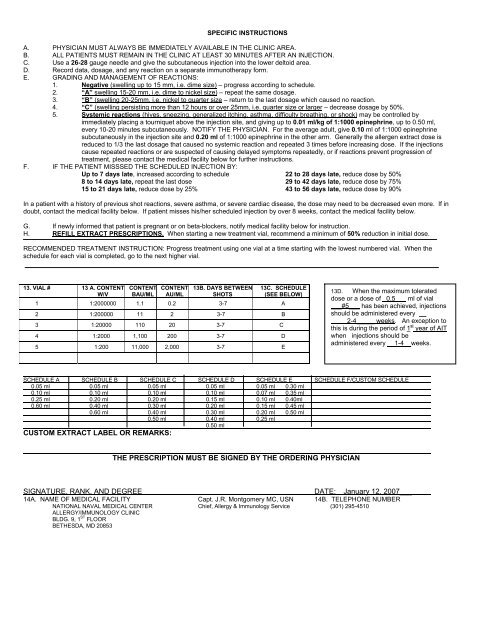Immunotherapy Safety for the Primary Care ... - U.S. Coast Guard
Immunotherapy Safety for the Primary Care ... - U.S. Coast Guard
Immunotherapy Safety for the Primary Care ... - U.S. Coast Guard
Create successful ePaper yourself
Turn your PDF publications into a flip-book with our unique Google optimized e-Paper software.
SPECIFIC INSTRUCTIONS<br />
A. PHYSICIAN MUST ALWAYS BE IMMEDIATELY AVAILABLE IN THE CLINIC AREA.<br />
B. ALL PATIENTS MUST REMAIN IN THE CLINIC AT LEAST 30 MINUTES AFTER AN INJECTION.<br />
C. Use a 26-28 gauge needle and give <strong>the</strong> subcutaneous injection into <strong>the</strong> lower deltoid area.<br />
D. Record data, dosage, and any reaction on a separate immuno<strong>the</strong>rapy <strong>for</strong>m.<br />
E. GRADING AND MANAGEMENT OF REACTIONS:<br />
1. Negative (swelling up to 15 mm, i.e. dime size) – progress according to schedule.<br />
2. “A” swelling 15-20 mm, i.e. dime to nickel size) – repeat <strong>the</strong> same dosage.<br />
3. “B” (swelling 20-25mm, i.e. nickel to quarter size – return to <strong>the</strong> last dosage which caused no reaction.<br />
4. “C” (swelling persisting more than 12 hours or over 25mm, i.e. quarter size or larger – decrease dosage by 50%.<br />
5. Systemic reactions (hives, sneezing, generalized itching, asthma, difficulty breathing, or shock) may be controlled by<br />
immediately placing a tourniquet above <strong>the</strong> injection site, and giving up to 0.01 ml/kg of 1:1000 epinephrine, up to 0.50 ml,<br />
every 10-20 minutes subcutaneously. NOTIFY THE PHYSICIAN. For <strong>the</strong> average adult, give 0.10 ml of 1:1000 epinephrine<br />
subcutaneously in <strong>the</strong> injection site and 0.20 ml of 1:1000 epinephrine in <strong>the</strong> o<strong>the</strong>r arm. Generally <strong>the</strong> allergen extract dose is<br />
reduced to 1/3 <strong>the</strong> last dosage that caused no systemic reaction and repeated 3 times be<strong>for</strong>e increasing dose. If <strong>the</strong> injections<br />
cause repeated reactions or are suspected of causing delayed symptoms repeatedly, or if reactions prevent progression of<br />
treatment, please contact <strong>the</strong> medical facility below <strong>for</strong> fur<strong>the</strong>r instructions.<br />
F. IF THE PATIENT MISSSED THE SCHEDULED INJECTION BY:<br />
Up to 7 days late, increased according to schedule 22 to 28 days late, reduce dose by 50%<br />
8 to 14 days late, repeat <strong>the</strong> last dose 29 to 42 days late, reduce dose by 75%<br />
15 to 21 days late, reduce dose by 25% 43 to 56 days late, reduce dose by 90%<br />
In a patient with a history of previous shot reactions, severe asthma, or severe cardiac disease, <strong>the</strong> dose may need to be decreased even more. If in<br />
doubt, contact <strong>the</strong> medical facility below. If patient misses his/her scheduled injection by over 8 weeks, contact <strong>the</strong> medical facility below.<br />
G. If newly in<strong>for</strong>med that patient is pregnant or on beta-blockers, notify medical facility below <strong>for</strong> instruction.<br />
H. REFILL EXTRACT PRESCRIPTIONS. When starting a new treatment vial, recommend a minimum of 50% reduction in initial dose.<br />
RECOMMENDED TREATMENT INSTRUCTION: Progress treatment using one vial at a time starting with <strong>the</strong> lowest numbered vial. When <strong>the</strong><br />
schedule <strong>for</strong> each vial is completed, go to <strong>the</strong> next higher vial.<br />
13. VIAL # 13 A. CONTENT<br />
W/V<br />
CONTENT<br />
BAU/ML<br />
CONTENT<br />
AU/ML<br />
13B. DAYS BETWEEN<br />
SHOTS<br />
13C. SCHEDULE<br />
(SEE BELOW)<br />
1 1:2000000 1.1 0.2 3-7 A<br />
2 1:200000 11 2 3-7 B<br />
3 1:20000 110 20 3-7 C<br />
4 1:2000 1,100 200 3-7 D<br />
5 1:200 11,000 2,000 3-7 E<br />
13D. When <strong>the</strong> maximum tolerated<br />
dose or a dose of _0.5___ ml of vial<br />
___#5___ has been achieved, injections<br />
should be administered every __<br />
2-4_____ weeks. An exception to<br />
this is during <strong>the</strong> period of 1 st year of AIT<br />
when injections should be<br />
administered every __1-4__weeks.<br />
SCHEDULE A SCHEDULE B SCHEDULE C SCHEDULE D SCHEDULE E SCHEDULE F/CUSTOM SCHEDULE<br />
0.05 ml 0.05 ml 0.05 ml 0.05 ml 0.05 ml 0.30 ml<br />
0.10 ml 0.10 ml 0.10 ml 0.10 ml 0.07 ml 0.35 ml<br />
0.25 ml 0.20 ml 0.20 ml 0.15 ml 0.10 ml 0.40ml<br />
0.60 ml 0.40 ml 0.30 ml 0.20 ml 0.15 ml 0.45 ml<br />
0.60 ml 0.40 ml 0.30 ml 0.20 ml 0.50 ml<br />
0.50 ml 0.40 ml 0.25 ml<br />
0.50 ml<br />
CUSTOM EXTRACT LABEL OR REMARKS:<br />
THE PRESCRIPTION MUST BE SIGNED BY THE ORDERING PHYSICIAN<br />
SIGNATURE, RANK, AND DEGREE DATE: January 12, 2007___<br />
14A. NAME OF MEDICAL FACILITY Capt. J.R. Montgomery MC, USN 14B. TELEPHONE NUMBER<br />
NATIONAL NAVAL MEDICAL CENTER Chief, Allergy & Immunology Service (301) 295-4510<br />
ALLERGY/IMMUNOLOGY CLINIC<br />
BLDG. 9, 1 ST FLOOR<br />
BETHESDA, MD 20853
















